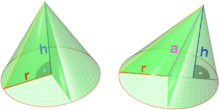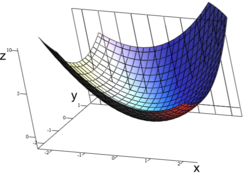Khác biệt giữa bản sửa đổi của “Đạo hàm riêng”
Dịch tạm vài dòng |
(Không có sự khác biệt)
|
Phiên bản lúc 12:35, ngày 12 tháng 5 năm 2012
Trong toán học, đạo hàm riêng của một hàm số đa biến là đạo hàm theo một biến, các biến khác được xem như là hằng số(khác vớiđạo hàm toàn phần, khi tất cả các biến đều biến thiên). Đạo hàm riêng được sử dụng trong giải tích vector và hình học vi phân.
Đạo hàm riêng của f đối với biến x được kí hiệu khác nhau bởi
Kí hiệu của đạo hàm riêng là∂. Kí hiệu này được giới thiệu bởi Adrien-Marie Legendrevà được chấp nhận rộng rãi sau khi nó được giới thiệu lại bởi Carl Gustav Jacob Jacobi.[1]
Introduction
Suppose that ƒ is a function of more than one variable. For instance,
The graph of this function defines a surface in Euclidean space. To every point on this surface, there are an infinite number of tangent lines. Partial differentiation is the act of choosing one of these lines and finding its slope. Usually, the lines of most interest are those that are parallel to the xz-plane, and those that are parallel to the yz-plane.
To find the slope of the line tangent to the function at (1, 1, 3) that is parallel to the xz-plane, the y variable is treated as constant. The graph and this plane are shown on the right. On the graph below it, we see the way the function looks on the plane y = 1. By finding the derivative of the equation while assuming that y is a constant, the slope of ƒ
Definition
Basic definition
The function f can be reinterpreted as a family of functions of one variable indexed by the other variables:
In other words, every value of x defines a function, denoted fx, which is a function of one variable.[2] That is,
Once a value of x is chosen, say a, then f(x,y) determines a function fa which sends y to a2 + ay + y2:
In this expression, a is a constant, not a variable, so fa is a function of only one real variable, that being y. Consequently, the definition of the derivative for a function of one variable applies:
The above procedure can be performed for any choice of a. Assembling the derivatives together into a function gives a function which describes the variation of f in the y direction:
This is the partial derivative of f with respect to y. Here ∂ is a rounded d called the partial derivative symbol. To distinguish it from the letter d, ∂ is sometimes pronounced "del" or "partial" instead of "dee".
In general, the partial derivative of a function f(x1,...,xn) in the direction xi at the point (a1,...,an) is defined to be:
In the above difference quotient, all the variables except xi are held fixed. That choice of fixed values determines a function of one variable , and by definition,
In other words, the different choices of a index a family of one-variable functions just as in the example above. This expression also shows that the computation of partial derivatives reduces to the computation of one-variable derivatives.
An important example of a function of several variables is the case of a scalar-valued function f(x1,...xn) on a domain in Euclidean space Rn (e.g., on R2 or R3). In this case f has a partial derivative ∂f/∂xj with respect to each variable xj. At the point a, these partial derivatives define the vector
This vector is called the gradient of f at a. If f is differentiable at every point in some domain, then the gradient is a vector-valued function ∇f which takes the point a to the vector ∇f(a). Consequently, the gradient produces a vector field.
A common abuse of notation is to define the del operator (∇) as follows in three-dimensional Euclidean space R3 with unit vectors :
Or, more generally, for n-dimensional Euclidean space Rn with coordinates (x1, x2, x3,...,xn) and unit vectors ():
Formal definition
Like ordinary derivatives, the partial derivative is defined as a limit. Let U be an open subset of Rn and f : U → R a function. The partial derivative of f at the point a = (a1, ..., an) ∈ U with respect to the i-th variable ai is defined as
Even if all partial derivatives ∂f/∂ai(a) exist at a given point a, the function need not be continuous there. However, if all partial derivatives exist in a neighborhood of a and are continuous there, then f is totally differentiable in that neighborhood and the total derivative is continuous. In this case, it is said that f is a C1 function. This can be used to generalize for vector valued functions (f : U → R'm) by carefully using a componentwise argument.
The partial derivative can be seen as another function defined on U and can again be partially differentiated. If all mixed second order partial derivatives are continuous at a point (or on a set), f is termed a C2 function at that point (or on that set); in this case, the partial derivatives can be exchanged by Clairaut's theorem:
Examples

The volume V of a cone depends on the cone's height h and its radius r according to the formula
The partial derivative of V with respect to r is
which represents the rate with which a cone's volume changes if its radius is varied and its height is kept constant. The partial derivative with respect to h is
which represents the rate with which the volume changes if its height is varied and its radius is kept constant.
By contrast, the total derivative of V with respect to r and h are respectively
and
The difference between the total and partial derivative is the elimination of indirect dependencies between variables in partial derivatives.
If (for some arbitrary reason) the cone's proportions have to stay the same, and the height and radius are in a fixed ratio k,
This gives the total derivative with respect to r:
Which simplifies to:
Similarly, the total derivative with respect to h is:
Equations involving an unknown function's partial derivatives are called partial differential equations and are common in physics, engineering, and other sciences and applied disciplines.
Notation
For the following examples, let f be a function in x, y and z.
First-order partial derivatives:
Second-order partial derivatives:
Second-order mixed derivatives:
Higher-order partial and mixed derivatives:
When dealing with functions of multiple variables, some of these variables may be related to each other, and it may be necessary to specify explicitly which variables are being held constant. In fields such as statistical mechanics, the partial derivative of f with respect to x, holding y and z constant, is often expressed as
Antiderivative analogue
There is a concept for partial derivatives that is analogous to antiderivatives for regular derivatives. Given a partial derivative, it allows for the partial recovery of the original function.
Consider the example of . The "partial" integral can be taken with respect to x (treating y as constant, in a similar manner to partial derivation):
Here, the "constant" of integration is no longer a constant, but instead a function of all the variables of the original function except x. The reason for this is that all the other variables are treated as constant when taking the partial derivative, so any function which does not involve will disappear when taking the partial derivative, and we have to account for this when we take the antiderivative. The most general way to represent this is to have the "constant" represent an unknown function of all the other variables.
Thus the set of functions , where g is any one-argument function, represents the entire set of functions in variables x,y that could have produced the x-partial derivative 2x+y.
If all the partial derivatives of a function are known (for example, with the gradient), then the antiderivatives can be matched via the above process to reconstruct the original function up to a constant.
See also
Notes
- ^ Jeff Miller (14 tháng 6 năm 2009). “Earliest Uses of Symbols of Calculus”. Earliest Uses of Various Mathematical Symbols. Truy cập ngày 20 tháng 2 năm 2010.
- ^ This can also be expressed as the adjointness between the product space and function space constructions.
External links
- Partial Derivatives at MathWorld















![{\displaystyle \nabla ={\bigg [}{\frac {\partial }{\partial x}}{\bigg ]}\mathbf {\hat {i}} +{\bigg [}{\frac {\partial }{\partial y}}{\bigg ]}\mathbf {\hat {j}} +{\bigg [}{\frac {\partial }{\partial z}}{\bigg ]}\mathbf {\hat {k}} }](https://wikimedia.org/api/rest_v1/media/math/render/svg/d3a85a7de9ee9f583d152b6e08c8d0e34afafeff)

![{\displaystyle \nabla =\sum _{j=1}^{n}{\bigg [}{\frac {\partial }{\partial x_{j}}}{\bigg ]}\mathbf {{\hat {e}}_{j}} ={\bigg [}{\frac {\partial }{\partial x_{1}}}{\bigg ]}\mathbf {{\hat {e}}_{1}} +{\bigg [}{\frac {\partial }{\partial x_{2}}}{\bigg ]}\mathbf {{\hat {e}}_{2}} +{\bigg [}{\frac {\partial }{\partial x_{3}}}{\bigg ]}\mathbf {{\hat {e}}_{3}} +\dots +{\bigg [}{\frac {\partial }{\partial x_{n}}}{\bigg ]}\mathbf {{\hat {e}}_{n}} }](https://wikimedia.org/api/rest_v1/media/math/render/svg/2c83e9cb78d0e11d52d23d1eebfd3b90e3bea09f)




















